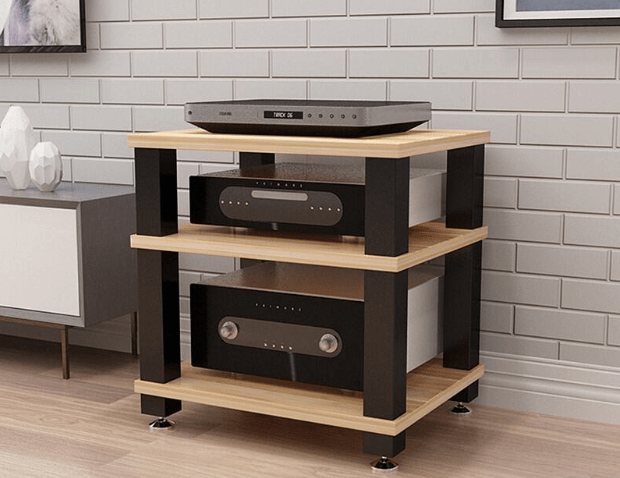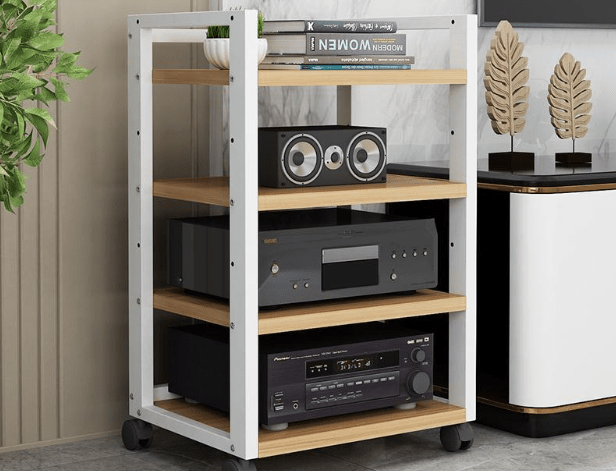When you finally saved up to assemble your first audio system, you made sure to follow all the expert advice. After reading product reviews and creating a short list, you visited your local dealer to discuss your options and purchased the system you found the most appealing.
But when you set up everything at home, your system doesn’t quite sound as you believe it should. And even though everything has been selected and connected with care, something is off. You begin to question whether all the effort and expenditure have been worthwhile.
Before you make any hasty decisions and try to resell your “disappointing” audio system on eBay, consider that what you may be missing is a good rack.
Why Does Every Audio System Need a Rack?
All audio system elements generate vibrations as a byproduct of their working. Although this vibration is hardly audible, it might upset the delicate electronic parts of your devices and degrade the sound. Excess vibration appears as noise and gives your audio an unnaturally harsh quality.
To mitigate this unfortunate effect, you need to rest all your equipment on a sturdy base that will provide stability and insulation. And this is where a quality HiFi stand rack comes in.
Any high-quality audio system must include a rack that can eliminate the vibrations and lower the noise that interferes with your signal. Also, a stand can act as a barrier between the different components to isolate them from each other and reduce interferences. Equipment with moving parts, such as CD players and turntables, vibrates more forcefully and thus needs to be well-isolated.
If you’re an audiophile, you probably have no problem shelling out a lot of money to make even the smallest changes to your sound quality. And a decent rack can unquestionably provide you with better audio. But, since a rack is not a compulsory component of the signal chain, you need not spend a fortune purchasing one.
How to Select the Right Option for Your System
It can be difficult to find the right audio racks and stands. There are absurdly many available choices, with an equal number of available features. To help you save time and choose an audio rack for your home quickly, intelligently, and appropriately, here’s a list of expert tips.
Materials
Most HiFi rack shelves are usually made of wood and glass, with budget options made of plastic. Many audiophiles prefer a wooden stand over a glass one since wood has a more dampening effect.
When it comes to wooden stands, bamboo is usually the best option. Bamboo is a highly absorbent material and can significantly reduce any vibrations. Another great choice is hardwood ply. Consisting of several layers with different resonances, many find that this material helps decrease a big chunk of the unwanted vibrations.
If you want something that will look more high-end and match your hardwood furniture, oak, mahogany and cherry stands are all great choices. There are also maple wood racks, but these are more expensive and also weigh a lot.
You may also prefer glass due to its seamless look. However, it won’t be able to reduce the vibrations as much as a wooden or plastic stand can.
Size
To choose the right size, consider how many components it needs to house. When combined with DVD players, line power conditioners, centre channel speakers, and other elements of a well-rounded setup, audio systems may become quite large very quickly.
Create a plan of the components that will be housed on your rack and where they will be before you commit to buying one. A sketch might help you anticipate some of the problems that might arise as you physically assemble the project.
With dimensions of around 60 cm wide, 45 cm deep, and 75 cm tall, the average audio rack is at a practical access height of about below the waist. Most audio receivers may be accommodated comfortably in the area on each shelf, which can range in height from 15 to 20 cm.
Avoid putting several components on a single shelf. The standard-sized audio rack’s shelf space is made to suit the fact that most A/V components require some level of air to disperse heat and operate normally.
Design
If you have a home studio, your rack essentially serves as furniture and allows you to display all of your expensive equipment. So, it must look beautiful and complement your entire decor.
Because of this, some people don’t mind spending a lot of money on an opulent rack even though it doesn’t really improve their music quality. Consider how much you’re willing to pay before you go shopping.
Cable Management Features
To prevent interference, it is preferable to keep cords from various devices separate from one another. Of course, if all of your cords are shielded, or even double-shielded, you won’t likely encounter a significant issue.
It is still preferable to be safe. So, you may want to look for a HiFi stand rack that offers ways to manage the different cables. If not, you might require loom tubing, velcro strips, and lacing bars. Whatever you do, avoid leaving a lot of cords hanging from your rack.
If you have kids or pets running around the house, an enclosed cable management system is a must. Despite the excellent design of modern wire, children and animals that grab onto or bite it runs the risk of being electrocuted. If you have an enclosed audio rack or stand with cable management ports, you can keep long cords well-hidden and out of the way to keep your family safe.
Price
Depending on how high up the ladder you go, the cost of good hi-fi racks can range from one or two hundred to thousands of pounds. However, even cheaper racks can offer a good solution. Regardless of the price, a good stand is one that’s level and low resonance.
In the hi-fi community, there is debate about whether the support should have a high or low mass, prioritise absolute rigidity, or offer decoupling. There are excellent examples of each style, therefore it pays to ask your dealer which type complements your kit the most.




